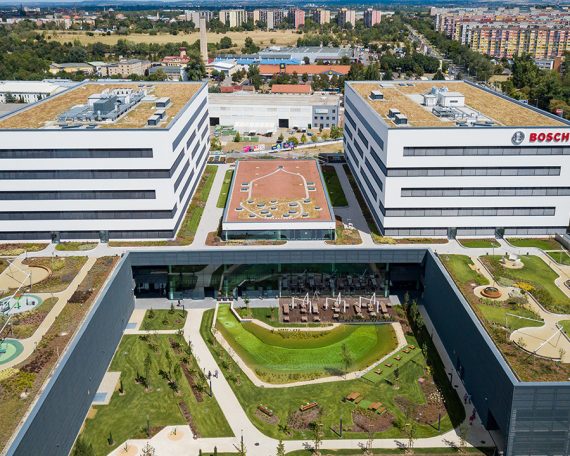Bosch Budapest Innovation Campus
The Bosch Budapest Innovation Campus is a vision of the workplace of the future, providing an inspiring and creative working environment for the employees. The design of the different functions is in line with the company’s new way of working concept. Taking into account the latest HR trends and feedback from employees, the architectural design placed particular emphasis on creating collaborative spaces for creative thinking and inspiration, and meeting rooms were equipped with state-of-the-art technology for professional online meetings. Working and recharging can not only happen inside but also in the roof garden and the green park surrounding the building. In addition to the basic functions, the main building includes a 500-seat auditorium equipped with state-of-the-art conference technology, which hosts professional, business, and artistic events in addition to internal events.
The Budapest Engineering Center is an important location for Bosch’s global developments. It is Bosch’s one of the largest development centers in Europe in terms of staff numbers. Around 3,000 experts – programmers, electrical engineers, mechanical engineers, physicists – are shaping the future, in particular the future of mobility, at Gyömrői út. The Bosch Budapest Innovation Campus is home to 1,800 next-generation workplaces, 14,000 square meters of instrumented research and test laboratories, a special outdoor test track and a high-tech giant test hall, all of which serve the company’s wide-ranging technological developments. “The new Bosch Budapest Innovation Campus will play a key role in the development of our electromobility and automated driving solutions. The creation of the new campus was brought to reason by the dynamic domestic growth of the Bosch Group and its next-generation development projects.” said Dr. István Szászi, representative of the Bosch Group in Hungary and in the Adria region.
An important part of the new Bosch campus in Budapest is the 10,000 square meter instrumented test track with its unique facilities. Here, ultrasonic, radar and camera-based driver assistance systems for the vehicles of the future can be measured and fine-tuned under controlled conditions on a wide variety of road surfaces and in a range of simulation situations. The enclosed test track has its own fuel and electric charging stations, and a special track lighting system has been installed to realistically simulate twilight and night-time lighting conditions.
One of the special features of the Bosch Budapest Innovation Campus is a test hall that can accommodate several semi-trailer trucks at the same time, where precision giant measuring chambers are to be used to develop and test the passenger and commercial vehicles of the future. In the test hall, special equipment used in the aerospace industry and aerospace technology will ensure extremely precise measurements for the fine sensors of the vehicles, while completely filtering out ambient vibrations.
Source: Bosch Media Service








Budapest
The history of Budapest is the history of three cities: Obuda, “old Buda”, Buda the high city found on the banks of the left bank, and Pest, found on the right bank.
The history of Budapest begins with the oldest city, Obuda, occupied by Celtic tribes until the conquest of the Romans in the 1st century BC. Obuda, which the Romans called “Aquincum”, was founded in the year 89 on an ancient Celtic settlement. For four centuries it was the capital of the Roman region of Pannonia. Aquincum comes from the word “aqua” (with water), in honor of the numerous thermal springs that Budapest is so famous for.
Buda was born as a Roman colony and its foundation was established around 14 BC.
In 896, seven Magyars tribes came together and defeated the Romans. They conquered the area and settled in Aquincum. Centuries later, in the thirteenth century, the settlement was called Óbuda and two separate cities began to develop on either side of the Danube River.
Hungary was established in 1000 AD as a Catholic Apostolic Kingdom with the coronation of the country’s first King, Stephen I of Hungary. In 1222, King Andrew II of Hungary issued the Golden Bull of 1222, the country’s first constitution.
In 1241, the Mongols invaded the area and both cities were completely destroyed. King Bélv IV of Hungary commissioned both towns to be rebuilt and during this period, Buda was founded opposite Óbuda.
Buda became the capital of the Kingdom of Hungary in 1361 and between the fourteenth and fifteenth century, the city developed greatly, decreasing after the reign of Matthias Corvinus, King of Hungary and Croatia.
Pest was conquered by the Ottoman Empire in 1526, followed years later by the siege of Buda in 1541. Buda was made capital of the Budin province during the Ottoman rule, while Pest declined and was practically abandoned. The Turks remained in power until 1686, year in which they were defeated by the Habsburg and Buda became part of the Habsburg dominion.
During the Habsburg rule, both cities began to develop again and many churches and landmarks were built during this period. In 1784, Joseph II established the Institutum Geometricum as part of the Faculty of Liberal Arts at the University of Buda. Count Széchenyi led a movement of progress in both cities and in 1849, the first permanent bridge was constructed connecting Buda and Pest. It is known as the Chain Bridge.
Unification of Óbuda, Buda and Pest
Óbuda, Buda and Pest were unified into one single city in 1873, naming the city Budapest. After Vienna, it became the second main city in the Austro-Hungarian Empire.
After World War I, the Allies and the Republic of German-Austria signed the treaty of Saint-Germain-en-Laye. ….
For further information, please feel free to follow links in the text those will direct to the source website.
Source: introducingbudapest.com